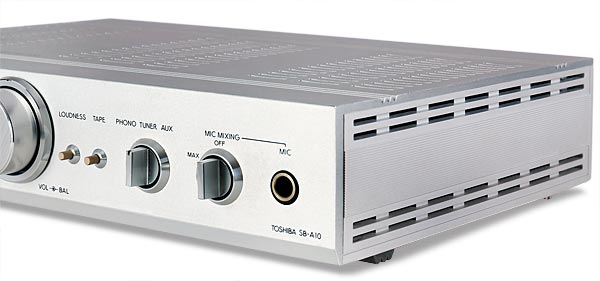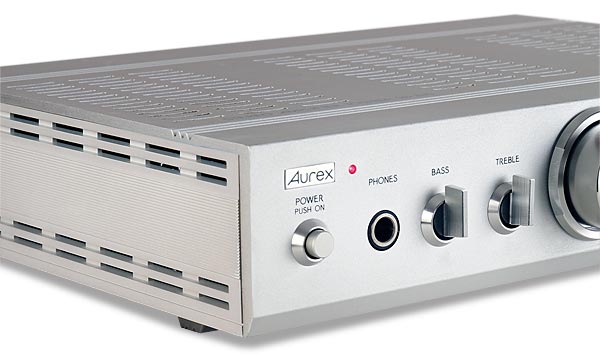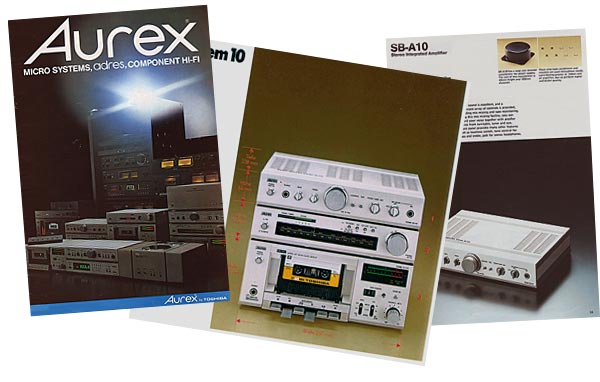Aurex SB-A10 amplifier

 As Lexus is to Toyota, so was Aurex to general CE brand Toshiba. We reappraise the SB-A10 – compact but full-featured, was this miniature hi-fi at its very best?
As Lexus is to Toyota, so was Aurex to general CE brand Toshiba. We reappraise the SB-A10 – compact but full-featured, was this miniature hi-fi at its very best?
In previous vintage reviews we have featured the Technics SL-10 turntable [HFN Apr '19] with its footprint the size of an LP sleeve, Sony's D-88 CD player [HFN Jul '16] that was so small the disc stuck out of its side, and Technics' SB-F1 speakers [HFN May '17], which individually could be held easily in the palm of one's hand. So how about a complete integrated amp about the same size as the concise edition of the Oxford English Dictionary? Meet the Aurex SB-A10 from 1981.
A sub-brand created by Toshiba in order to bring its premium products to market – just as National Panasonic did with Technics, and Toyota with its 'Lexus' range in the car market – Aurex set the pace for a new breed of tiny hi-fi with the launch of its Micro System 15 in 1979 [HFN Apr '16].
All Systems Go
At around £1000 for the pre and power amplifiers, tuner and cassette deck it wasn't cheap, but it outperformed rivals from Technics' Concise Components series and the Aiwa '22' system, as well as much full-sized equipment. To broaden the appeal of the micro components range Aurex soon supplemented the expensive '15' system with the '10' at £399 and then the '12' (£499). The SB-A10 was the amplifier used in the '10' system, one obvious simplification being that it was an integrated rather than a pre/power amp.

The '10' system also included a simpler cassette deck (PC-D10) with mechanical keys rather than logic controls and a more basic tuner (ST-T10L). The external appearance of this unit was all but identical to the ST-T15L's in the '15' series, assuming that this was chosen over the more expensive digitally-tuned ST-F15. The '12' system, meanwhile, looked more like the '15', especially once the PC-D12 cassette deck was launched (early System 12s came with the PC-D10). However, all the components underwent heavy cost reduction in order to halve the selling price. This was the key difference between the '10' and '12' systems, the '10' being a simpler and smaller alternative to the '15', while the '12' was simply a cheaper one.
No Plaything
The SB-A10 was an impressive piece of work. Building the whole amplifier into the space previously occupied by the SY-C15 preamp alone was not an easy proposition, even though the circuits used were not as elaborate and, at 2x20W/8ohm [see PM's Lab Report, p127], the output was half that of the SC-M15 power amp. The SB-A10 was also much cheaper than just the SY-C15 on its own, costing £145 compared to £220. From this one might have assumed that the new integrated was little more than a toy, something that looked like the real thing but lacked many of its finer qualities.
This was not the case, even though, as with the rest of the Aurex micro components range, there was nothing particularly clever or novel about the design of the SB-A10. Instead, conventional electronic engineering best practice had been applied in a careful and considered manner, the smallness of the unit a result of the high-density packaging of all the parts.

Inside you will find no switchmode PSU and no clever heatsinks. Rather, you discover a conventional Class AB amplifier powered by as large a toroidal mains transformer as would fit into the cabinet (not quite, as it actually sticks out through a hole in the bottom!).
During the late 1970s other Japanese manufacturers had evolved a topology for low-cost hi-fi amplifiers with a simplified circuit based around hybrid chip modules. In this arrangement all the gain required for line level inputs (tuner, tape, etc) was generated within the hybrid chip itself.
On The Block
When it came to tone controls, these were implemented by placing the adjustments in the amplifier's negative feedback loop so no additional circuitry was required. The only other active components necessary were in the obligatory phono stage and to provide loudspeaker protection (if fitted).
This economical format would have been easy to squeeze within the dimensions of the Aurex micro components, but Toshiba's engineers chose the template used for units higher up the price scale, which performed better. This meant a discrete fully complementary OCL output stage preceded by a separate low-level gain block where the treble and bass controls acted. Meanwhile, the MM phono stage was independent of the main signal path and was built around a pair of specially designed Toshiba ICs. Headroom was maintained by running them from a split supply of ±18V, the highest voltage the chips would reliably tolerate.

Other 'big amplifier' features included electronic loudspeaker protection with a relay to isolate the output if anything went wrong, a properly implemented tape loop and a ¼in headphone jack, correctly attenuated of course. One curious addition was a microphone mixing input (mono) on the amp's front panel, which is of no real value to the typical audiophile.
The SB-A10 may have been keenly priced but it doesn't feel cheaply made, even compared to the luxurious SY-C15. Yes, the sides, back and base are of resin instead of alloy but the one-piece top and fascia have the same shot-peened metal finish as the components in the '15' range. And all the knobs and switches are machined aluminium, not plastic.
The rear panel sees the input sockets (not gold-plated this time) vertically aligned with those of the source components, making set-up of the full system simple. The spring-clip speaker terminals are less impressive than the sturdy binding posts on the SC-M15 power amplifier, but given the space constraints they can be considered perfectly adequate.
Of course, all the signal levels are standard so the SB-A10 can be combined with peripheral components of almost any origin, aside from the fact that the turntable input is suitable for MM cartridges only. There is even an auxiliary input for a CD player, correctly arranged so that high-level signals cannot overload it.























































